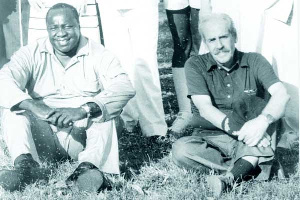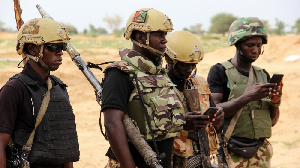How CIA harboured intention to kill Idi Amin

The Central Intelligence Agency (CIA), the US foreign intelligence outfit, singled out former Uganda president Idi Amin for assassination in 1977.
Barely two years before his overthrow by liberation fighters, who were shored up by his implacable foe, Julius Nyerere, the Western capitals depicted Amin as a ruthless leader whose capricious behavior sealed the fate of thousands of his victims trapped in underground torture dungeons.
But some commentators have argued that the West embellished Amin’s gross human rights record to push for a narrative against a leader who rejected a neo-colonial and imperialistic agenda against Africa.
During his confirmation hearing in 1977, Stansfield Turner, who was then US president Jimmy Carter’s nominee to head the CIA, was asked if he could think of a situation where he might approve the assassination of a foreign head of state.
Admiral Turner replied: “Not in peacetime. But, I wonder. I wonder if the world wouldn’t really be a better place if the CIA were to assassinate or assist in the assassination of Uganda’s president Idi Amin.”
This revelation is part of 13 million pages of declassified documents from the CIA recently released online. The release was prompted by a lawsuit against the CIA filed by information advocates.
Turner revealed further, “I believe with my deepest conviction, that the greatest strength we have as a world power is our moral dedication to the rights of the individual. Well, I agree wholeheartedly and this is my point. What better way to demonstrate to the world the depth of our moral dedication to the rights of individuals than to have the CIA arrange one of those fatal ‘auto accidents’ for Idi Amin. In fact, after this is accomplished, the agency might even want to hold a press conference and claim credit for the operation.”
The cloak and dagger games
Turner’s “auto accidents” lexicon, which perhaps meant a staged accident, provides an insight into the cloak and dagger world of espionage and the conduct of the CIA’s covert operations anchored on its ‘moral obligation’ to restore a modicum of sanity by cherry-picking despotic leaders across the world for assassination.
Turner became the director at the time the CIA faced flak in the wake of congressional hearings into unsavory clandestine operations. In testimony, investigators said the CIA had tested experimental drugs on human subjects, plotted to assassinate foreign dignitaries, and illegally spied on American citizens.
It is not clear yet why the plan to assassinate Amin was shelved.
Amin is portrayed in the CIA scripts as a leader that ingratiated himself with assassins, bomb-making experts, and international gunrunners.
Among this intricate web of an international criminal underworld was an officer with a storied career as a CIA agent.
A gathering of merchant of deaths
It was September 23, 1976, when four men met secretly in a private home in the Ugandan capital of Kampala. The CIA files referred to the meeting as ‘a gathering of merchant of deaths.’
Outside, the reign of terror launched by Uganda’s dictator Idi Amin was in full motion, reads the CIA records.
“Inside the house, the talk was of Amin’s dreaded secret police and of international terrorist activities. The four men were among the world’s most cold-blooded, dangerous architects of political murder and mayhem. A single grenade tossed into the conference room could have spared the world much pain and misery in the years to come. But there was no one there to turn the table on the four professional assassins,” read the scripts.
Robert Astles, in whose home the ‘dialogue of death was conducted’, was Amin’s British-born security adviser and general factotum. In his role as Amin’s right-hand man, Astles was allegedly the brains behind the security police that butchered and tortured thousands of Ugandans during Amin’s rule.
After Amin and Astles fled Uganda in 1979, the Briton was brought in chains to face charges of murder. But in September 1976, he was still riding high, the CIA scripts read.
Another participant was Wadi Hadad, known to some of his enemies as the ‘doctor of death’ for masterminding the 1972 Munich massacre of Israeli Olympic athletes.
Less than three months earlier, the Israelis had thwarted Hadad’s hijacking of a jetliner by their daring raid on Entebbe. After many hairbreadth escapes, including an Israeli bazooka blast into his hotel suite, Hadad died of natural causes in 1978.
The third man was the Venezuela-born assassin, Carlos the Jackal, a leftist militant. He was accused of planning the Munich massacre and was responsible for the kidnapping of the Opec oil ministers in December 1975, as well as many other acts of international brigandage.
In 2017, he was found guilty by a French court over a grenade attack in 1974 on a shop on Paris’s Champs Elysees, the Drugstore Publicis that killed two people and injured 36.
Carlos, whose real name is Ilich Ramirez Sanchez, was born in Venezuela, is serving two other life terms and has lost appeals against them.
The fourth man in the gathering of professional cutthroats was an American, Frank Terpil, an officer who previously worked with the CIA and later turned into a snitch and helped ship arms to tin-pot dictators across the world.
A newcomer to the inner circle of international terrorism, Terpil had arrived in Uganda with the personal recommendation of Libyan dictator Muammar Gaddafi, a close ally of Amin.
As a CIA courier some years before, Terpil had struck a relationship with Gaddafi when the future dictator was a junior officer in the Libyan army and revolution was burning in his head.
Of the four, Terpil probably best fitted the description ‘merchant of death’, the CIA files read. Not one to risk his own neck, he supplied explosives and other items that enabled hitmen to carry out their acts of terrorism around the world. He later fled the United States to avoid prosecution for illegal shipment of arms to Libya.
Intelligence sources claim that the September 23 meeting was Terpil’s introduction to Amin’s inner circle. With his macabre references from Gaddafi, Terpil signed his first contract with Amin in 1977. It was worth $3.2 million worth of weapons and communications gear, the records claim.
Terpil began providing Astles’ security police with torture equipment, taser electronic shock guns, and other deadly hardware. One of Terpil’s associates was to boast later about the torture he devised that required sophisticated equipment. It consisted of a rat placed on a victim’s stomach under an invented pot, requiring the rat to gnaw its way through a victim’s stomach.
According to the CIA records, Terpil’s lucrative contract with Amin was followed by several more before the tyrant was finally driven from power.
American’s shipments of weapons and torture devices to Amin were so ill-concealed that a Ugandan diplomat to the United Nations after Amin’s fall told federal investigators he was appalled that a US citizen could conduct the activities that Mr. Terpil had conducted.
The diplomat indicated his belief that Terpil’s former employer, the CIA, could easily have stopped his nefarious trade at any time.
Earlier on, the CIA it is stated in the records hauled arms and flew military missions against rebels fighting Amin at the time the African nation was under a US military embargo for human rights violations.
The activity, which was carried out in 1976, may have been illegal but the CIA gave in to Amin’s request for fear of losing ‘a spying operation it had established in Amin’s air service.’
The spies in Amin’s four-plane air service supplied Western intelligence services with extraordinarily detailed information about Amin’s activities, former US president and head of the CIA between 1976-1977, George W. Bush when some of the flights occurred said ‘no comment at this time through his press office.
The said flights were made in planes sold to Amin by page Airways of Rochester and by a Swiss dealer who actually was an Israeli intelligence agent.
According to the records, in one of the depositions, a pilot described how Southern Air and Page employees transported weapons, smuggled in stolen US military equipment, and engaged in military operations against Ugandan rebels for Amin. Two Southern aircrew members said they were told to transport weapons and assist military operations to remain in Amin’s good graces.
The aircrews were supplied by Southern Air transport of Miami once secretly owned and operated by the CIA, which flew weapons destined for Iran to the Middle East and also shipped arms to Nicaragua contras, in what came to be known as the Iran-Contra scandal.
The United States government had secretly arranged arms sales to Iran through Israel and used the profits to fund Nicaraguan contra rebels. In this deal, two separate American foreign policy schemes were joined in the expectation of mutual benefit.
The United States backed the contras rebels who were fighting against the left-wing Sandinista government as part of its policy of preventing the spread of leftist movements around the globe.
In Iran, the American government hoped to appease purported ‘moderates’ in the Iranian government with arms sales in order to secure their help in effecting the release of American hostages held by pro-Iranian groups in Lebanon.
During an interview broadcast in the 1982 documentary, Confessions of a Dangerous Man, the former CIA agent admitted having a permanent office in the State Researches Institution in Kampala.
Amin’s victims are known to have been tortured in the basement. Terpil claimed he was not fully aware of what was going on.
“It was a domestic issue,” he later said in Havana, Cuba.
The night Amin’s rule finally ended, on April 13, 1979, Terpil was on the presidential plane to Libya. He recalls loading steel trunk-loads of gold onto the aircraft, just before they flew out from Entebbe.
In 1980, Terpil was indicted by a US court on charges that included the illegal delivery of 20 tonnes of plastic explosives and the attempted sale of 10,000 machine guns to Gaddafi.
Terpil skipped bail and left the country on a commercial flight out of Washington DC. In 1981, he was sentenced in absentia to 53 years in jail. The judge said he deserved to serve every day of the jail term, describing his line of work as a “trade-in death and destruction”.
Terpil also gave a description of Amin as a deranged man who at one time served the severed head of an assassinated minister for dinner. But this was not independently verified and appears to have been part of the exaggerated tales about Amin.
Plot to assassinate former Kenyan minister
Terpil, who had earlier on in 1973 sold eavesdropping equipment to Amin’s regime, is also accused of participating in the liquidation of Kenya’s only White cabinet minister in the Jomo Kenyatta government, Bruce McKenzie, formerly a British intelligence spy and wheeler-dealer.
McKenzie’s twin-engine Piper Aztec 23 plane exploded over Ngong Hills, a few minutes after 6 pm on May 25, 1978, as he flew back from a meeting with Amin.
According to the CIA scripts, “A liquid bomb hidden in the lion’s head trophy in the cargo compartment had been detonated by a sophisticated electronic device.”
McKenzie is believed to have provided crucial information to help the Israelis raid at Entebbe airport to rescue hijacked citizens.
Amin’s fixer, Astles, had close ties with McKenzie for a number of years and had struck a car deal with the Kenyan-based Cooper Motors Corporation to supply Land Rovers to be used by the dreaded State Research Bureau; as a result, McKenzie was also a supplier to Amin.
After his retirement from Kenyatta’s cabinet in 1969, McKenzie had secured the Volkswagen dealership in East Africa with Kenya’s then powerful Attorney General, Charles Njonjo, and was the middleman for the purchase of Vickers tank by Kenya in 1976. Astles had turned to McKenzie to deliver radio equipment to Amin’s intelligence outfits from UK’s Pye Telecommunication through its Kenyan distributor Wilken Telecommunications Limited.
This company was owned by McKenzie and Keith Savage and supplied Amin with VHF-FM radiotelephone systems and Land Rovers ostensibly designed to “detect television license dodgers”.
In 1976, another British company, Contact Radio and Telephone, had built a bulletproof broadcasting station for Amin, which could be used in times of war and emergency.
It was also revealed that both McKenzie and Savage made several trips to Uganda and held lengthy talks with Amin. One of the passengers aboard the ill-fated flight was Gavin Whitelaw, a representative of Vickers – a British company that built battle tanks for export. This led to speculation that McKenzie’s trip was possible to secure an arms sales deal.
Amin’s ties to Mossad
Amin had earlier on been sucked into the intelligence orbit before he became president.
As army commander during the Obote I government in the 1960s, Amin briefly enrolled in a paratrooper course and became friends with Col Baruch Bar-Lev, Israel’s military attaché in Uganda.
Amin, who was Kakwa, a tribe that straddles the Uganda-South Sudan border, approved of Israeli’s support to the Anyanya rebellion in the neighboring state, which was fighting the Arab-led Khartoum regime.
The New Yorker reported in 2016 that during a trip to Cairo, Egypt, according to the Israeli military historian Yehuda Ofer, Amin called Bar-Lev because he was worried that, when he returned, he would be arrested for the murder of an Obote ally.
Bar-Lev was eager to help Amin, who was serving Israel’s interests in Sudan, and he advised the Ugandan commander to form a battalion within the army to protect himself. The Israelis would train it. This unit, consisting of paratroopers, tanks, and armed jeeps, proved instrumental a few months later when, in January 1971, Amin overthrew the regime while Obote was in Singapore for a meeting of the British Commonwealth.
According to CIA files, it is not clear whether it was the British MI6 or Israeli’s intelligence outfit, Mossad, that took the lead in plotting to overthrow Amin but the two seemed to have worked together to aid the putschists against Obote.
When he first came to power, Amin was avowedly pro-British – grateful for the UK’s early recognition of his regime – and pro-Israel – loud in his praise for their assistance to Uganda’s military establishment. He made his first diplomatic visit to Israel.
But later on, the West accused Amin of being volatile and paranoid as the ‘conqueror of the British Empire’ often claimed that the British, Israelis and other Western nations were plotting to assassinate him. Israelis’ plots and machinations thereafter became the favorite scapegoat for Amin’s ills, read the CIA scripts.
Timothy Kalyegira, a researcher and journalist, says in intelligence, principles, morals or laws do not matter.
“The core of an intelligence service is to protect a state’s security by keeping the state one step ahead of its enemies or any threats. To do so, it must know the intentions of its enemies and where these enemies keep the information secret; the intelligence services must find a way to get it,” Kalyegira says. “If a prostitute has access to that information, they will work with her. Then end goal is the only thing that matters.”
The scripts claim that Amin ordered his troops at the border to “shoot on sight any Israeli attempting to cross the border into Uganda and his subsequent accusations of British plots and sabotage accompanied by observations as to what good targets white faces would make for his troops alarmed the foreign community”.
Kalyegira also explains why intelligence outfits build notoriously fickle alliances. “So that is why intelligence services usually do things that seem like a contradiction. If, for example, China uses the exit of the United States from Afghanistan to fund infrastructure projects, and then build a huge military base from which to project Chinese power into Central Asia, this move by China is a red-alert threat to the West.
So the CIA and Britain’s MI6 will secretly work with some Taliban leaders who don’t like godless China,” he argues.
The CIA files quoting Amnesty International claim that under the Amin regime 300,000 civilians, 10,000 soldiers, and 3,000 policemen were killed during the reign of terror.
The International Commission of Jurists estimates that as many as 250,000 Ugandans may have been killed for alleged plots against Amin and in purges against his opponents.
At one time, the CIA files claim, the Nile became so clogged with bodies of Amin’s victims that they were clearly visible from the giant Owen Falls Power station and several Italian engineers working there quit in disgust.
History
Amin’s ties to Mossad
Amin had earlier on been sucked into the intelligence orbit before he became president.
As army commander during the Obote I government in the 1960s, Amin briefly enrolled in a paratrooper course and became friends with Col Baruch Bar-Lev, Israel’s military attaché in Uganda.
Amin, who was Kakwa, a tribe that straddles the Uganda-South Sudan border, approved of Israeli’s support to the Anyanya rebellion in the neighboring state, which was fighting the Arab-led Khartoum regime.
Source: monitor.co.ug






